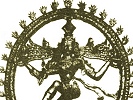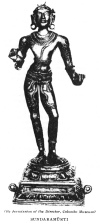
Hymns of the Tamil Saivite Saints, by F. Kingsbury and G.P. Phillips, [1921], at sacred-texts.com

Click to enlarge
SUNDARAMŪRTI
SUNDARAMŪRTI SWAMI AND HIS HYMNS
III.
SUNDARAMŪRTI SWAMI
(Abbreviated as SUNDARAR)
The third of these hymn-writers, named in full Sundaramūrti Swāmi, was, like Sambandar, a Brahman. He was born in the South Arcot District, and is generally believed to have flourished in the first quarter of the ninth century A.D. He evidently sat loose to caste scruples, for neither of his two wives was a Brahman. One was a dancing-girl in the Śaivite temple at Tiruvārūr, the modern Tiruvalur in the Tanjore District, while the other was a Vēḷāḷa woman of Tiruvottiyūr, now a suburb of Madras. His life seems to have been no happier than life in polygamy usually is, and to add to his difficulties he sometimes found himself without food for his ladies to eat. He frankly praised God for what he could get, and on the whole his hymns are on a lower spiritual plane than those of the first two writers, though there are some which bear the marks of real spiritual experience. Of the sixty-three saints whom Śaivites hold in special honour, Sundarar seems to have been the last, for he sang the praises of the other sixty-two.
Sundarar, as our first sample of him shews, was not only later than the two authors whom we have been studying; he was the last of the sixty-three canonized saints of Śaivism. A serious weakness of the religion here shews its head. Śiva has his favourites, who can do no wrong. The stanza is given in prose, for these names cannot fit into any English metrical line. The first two will be recognised as names of the poets whose work we have been considering. Nāḷaippōvān is Nandan, the pariah saint. Silandi (= spider) is Kōchchengaṭ Chola, who figures largely in early Tamil history.
To English ears the metre of the next two verses, which are common favourites, has a curious sound. It is a close reproduction of the Tamil, so close that the tune of the Tamil hymn could be sung to the English words.
Fair shines Thy tangle of hair, crowned with blooms from the kondai's bright tree,
Sov’reign, great jewel art Thou, the red ruby of Mal̤apāḍi,
Mother, on Thee, none but Thee, can my heart evermore fixèd be.
Lo I have come to Thy foot; O my head, I beseech Thee, take me.
Portion of sword-eyed Umā, Thou red ruby of Mal̤apāḍi,
Friend, ’tis on Thee, none but Thee, can my heart evermore fixèd be.
Is the Śiva manifested at one shrine so distinct from the Śiva manifested at another as to endanger the unity of God? If tradition is right, the danger is very real, for Sundarar was already worshipping at one shrine, Tiruvottiyūr, when he remembered the lord of Ārūr, and deciding to go to him like a returning prodigal, sang this stanza.
Now know I well the meaning of my sickness and my pain.
I will go worship. Fool! how long can I so far remain
From Him, my pearl, my diamond rare, the king of great Ārūr.
The joy in God which shines in our next hymn evidently rests on some experience of divine grace which we should have liked to hear more definitely described.
Thou lord of men, thou fount of grace,
How to forget Thee could I bear?
My soul hath aye for Thee a place.
Veṇṇey-nallūr, in "Grace's shrine"
South of the stream of Peṇṇai, there
My father, I became all thine;
How could I now myself forswear?
Without a single thought of Thee,
Roamed and grew weary, then such grace
As none could win Thou gayest me.
Veṇṇey-nallūr, in "Grace's shrine"
Where bamboos fringe the Peṇṇai, there
My Shepherd, I became all thine;
How could I now myself forswear?
No creeping age, bull-rider mine.
Sinful and full of lying breath
Am I, hut do Thou mark me Thine.
Veṇṇey-nallūr, in "Graces shrine"
South of the wooded Peṇṇai, there
My Master, I became all thine;
How could I now myself forswear?
The varying mood of the saint, now joyous and triumphant, now plaintively looking for death, is reflected in the next two verses from one hymn.
I'm born anew, from this time forth I pass the way of birth no more.
In Koḍumuḍi, lord austere, where wise men Thee with praises greet,
Should I forget Thee, my own tongue 'Hail, Śiva'! crying, would adore.
This, naught but this, is all my thought. But, lord of speech, Thou light on high,
Where the bright streams of Kāviri to Koḍumuḍi coolness lend,
Should I forget Thee, my own tongue to Thee would loud 'Hail, Śiva' cry.
God should deliver His own from death. The appeal here is to the familiar story of Markandeya (see No. 3). Yama is the god of death who gathers in the souls of men.
To save him, Thou grim Death did’st slay,
Such deeds Thy might accomplisheth,
And I who have beheld them pray
"O Father, should dread Yama press
On me, forbid him. ’Tis my slave";
Do Thou in green Pungūr confess.
I've reached Thy foot, and Thou can’st save."
Sundarar is sure that Śiva will understand his perplexities in supplying the needs of his fair ladies. For does not Śiva Himself bear the burden of two ladies, Pārvati his consort, and Gangā (lady Ganges) in his hair? Sundarar, in the legend with which these verses are connected, when one of his wives was suffering hunger, miraculously received some uncooked rice from Śiva. This was not enough; to complete the miracle Śiva must remove the rice for him to Ārūr the abode of his fair one. This too was done in answer to the hymn of which the next two stanzas are a sample.
Daily in worship I bow;
She of the sword-piercing eyes,
Leave her not suffering now.
Kōḷili's lord, Thou didst give
Rice in Kuṇḍaiyūr this day.
No man to bring it have I,
Bid it be sent me, I pray.
Gaṅgā is in Thy long hair.
Full well canst Thou comprehend
Burden of women so fair.
Kuṇḍaiyūr circled with gems,
There didst Thou give rice to-day.
Source of all, wonderful one,
Bid it be sent me, I pray.
The saint advises his fellow-poets to sing the praises of Śiva rather than the praises of men because they seldom reward the poets. Śiva rewards them here and hereafter. The Pāri mentioned in 78 was a chieftain in the Tamil country in the early centuries of our era, famed for his liberality.
They to saints will nothing give;
Sing not them, O poets wise,
But if ye would wealth receive
Sing the Sire of Puhalūr;
Here your wants will be supplied,
Pain will flee; there evermore
Ye will kings in heav’n abide.
Style him Arjun with his bow,
Give the mean man Pāri's fame,
Not a gift will he bestow.
Sing, O bards, our holy God,
White with ash, in Puhalūr.
In the deathless one's abode
Ye shall reign for evermore.
Life and experience have no value, no reality. God alone is real, the refuge from the unreal.
Its end is only dust,
Out of the sea of birth
Come ruin, pain and lust.
Delay not to do good
But praise Ketāram's king,
Whom Vishṇu and great Brahm
Vainly sought sorrowing.

